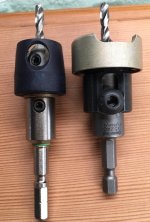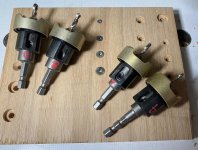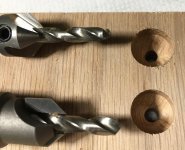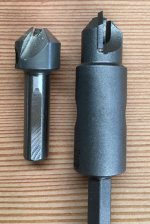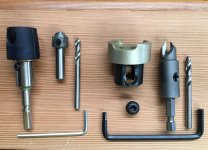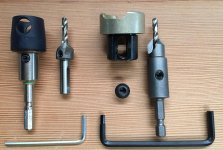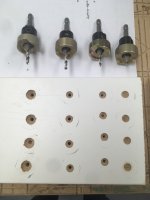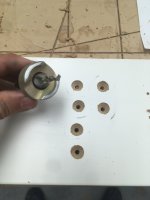JonathanJung
Member
- Joined
- Apr 7, 2018
- Messages
- 257
Looking for a great set of countersinks for hardwoods with non-marring adjustable depth stops. I primarily will use them for installing drawer fronts, handles, cabinets, and general flush screwing with normal screws, like from McFeely's. I'd like to cut clean, round, countersink holes, with a replaceable bit, rock solid depth stop, and will get a set for each size screw. The idea of using any type of bit is great - tapered, brad point, slow spiral, or regular.
My basic set of Snappy's cut terribly:https://www.amazon.com/Snappy-Quick...tersink+depth+stop&qid=1629602397&sr=8-7&th=1
Here's the drills I am aware of:
Amana, carbide, ball bearing stop, tapered bithttps://www.routerbitworld.com/Amana-55150-Carbide-Tipped-82-Degree-Countersink-w-p/amana-55150.htm
Amana, carbide, AlTin coated, ball bearing stop, straight bithttps://www.routerbitworld.com/Aman...mance-Carbide-Tipped-AlTi-p/amana-55206xl.htm
Amana, carbide, ball bearing stop, slow spiral bithttps://www.routerbitworld.com/Amana-55272-Replacement-Carbide-Tipped-Countersink-p/amana-55272.htm
Amana, carbide, low-friction stop, straight bithttps://www.routerbitworld.com/Amana-55294-Carbide-Tipped-82-Degree-Countersink-w-p/amana-55294.htm
Lee Valley, look like Amana?https://www.leevalley.com/en-us/sho...untersink-drills-with-low-friction-depth-stop
Festool (expensive, worth it?)https://www.festoolproducts.com/fes...ping&msclkid=a85c7bdf3547105708fb1afe8bd126c3
Fisch, I like their forstner bits, so why not?https://www.woodcraft.com/products/fisch-adjustable-countersink-bit-1-8-5-16-d-x-1-3-8-oal#
Whiteside, would need additional depth stophttps://www.whitesiderouterbits.com/collections/high-speed-steel-countersinks
Fuller, HSS, tapered, only 2 depth stops - I'd like one for each cutter, and I don't need plug cuttershttps://www.amazon.com/Fuller-Taper...032YZ060/ref=sr_1_11?dchild=1&keywords=fuller+countersink+drill+and+plug+cutter&qid=1625361251&sr=8-11
Snappy, low friction non marring ball bearing stop, straight bithttps://www.amazon.com/Adjustable-F...1BLWL2Q6/ref=sr_1_10?dchild=1&keywords=fuller+countersink+depth+stop&qid=1629602397&sr=8-10
What else am I'm missing? Which would you recommend? I shouldn't need tapered, right?
My basic set of Snappy's cut terribly:https://www.amazon.com/Snappy-Quick...tersink+depth+stop&qid=1629602397&sr=8-7&th=1
Here's the drills I am aware of:
Amana, carbide, ball bearing stop, tapered bithttps://www.routerbitworld.com/Amana-55150-Carbide-Tipped-82-Degree-Countersink-w-p/amana-55150.htm
Amana, carbide, AlTin coated, ball bearing stop, straight bithttps://www.routerbitworld.com/Aman...mance-Carbide-Tipped-AlTi-p/amana-55206xl.htm
Amana, carbide, ball bearing stop, slow spiral bithttps://www.routerbitworld.com/Amana-55272-Replacement-Carbide-Tipped-Countersink-p/amana-55272.htm
Amana, carbide, low-friction stop, straight bithttps://www.routerbitworld.com/Amana-55294-Carbide-Tipped-82-Degree-Countersink-w-p/amana-55294.htm
Lee Valley, look like Amana?https://www.leevalley.com/en-us/sho...untersink-drills-with-low-friction-depth-stop
Festool (expensive, worth it?)https://www.festoolproducts.com/fes...ping&msclkid=a85c7bdf3547105708fb1afe8bd126c3
Fisch, I like their forstner bits, so why not?https://www.woodcraft.com/products/fisch-adjustable-countersink-bit-1-8-5-16-d-x-1-3-8-oal#
Whiteside, would need additional depth stophttps://www.whitesiderouterbits.com/collections/high-speed-steel-countersinks
Fuller, HSS, tapered, only 2 depth stops - I'd like one for each cutter, and I don't need plug cuttershttps://www.amazon.com/Fuller-Taper...032YZ060/ref=sr_1_11?dchild=1&keywords=fuller+countersink+drill+and+plug+cutter&qid=1625361251&sr=8-11
Snappy, low friction non marring ball bearing stop, straight bithttps://www.amazon.com/Adjustable-F...1BLWL2Q6/ref=sr_1_10?dchild=1&keywords=fuller+countersink+depth+stop&qid=1629602397&sr=8-10
What else am I'm missing? Which would you recommend? I shouldn't need tapered, right?

